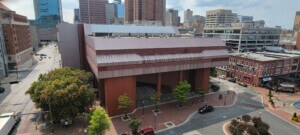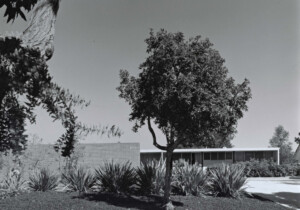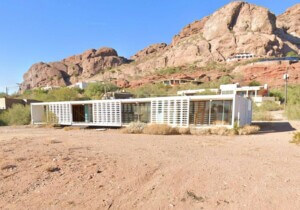New Yorkers may soon be able to live in the landmark McGraw-Hill building under a new plan by its current owners for bringing the now-vacant building back to life in a post–COVID 19 real estate market.
New York’s Landmarks Preservation Commission (LPC) on Tuesday approved changes to the building’s exterior that were requested to make the residential use possible, primarily involving conversion of the original main entrance previously used by office workers to a dedicated entrance for future residents.
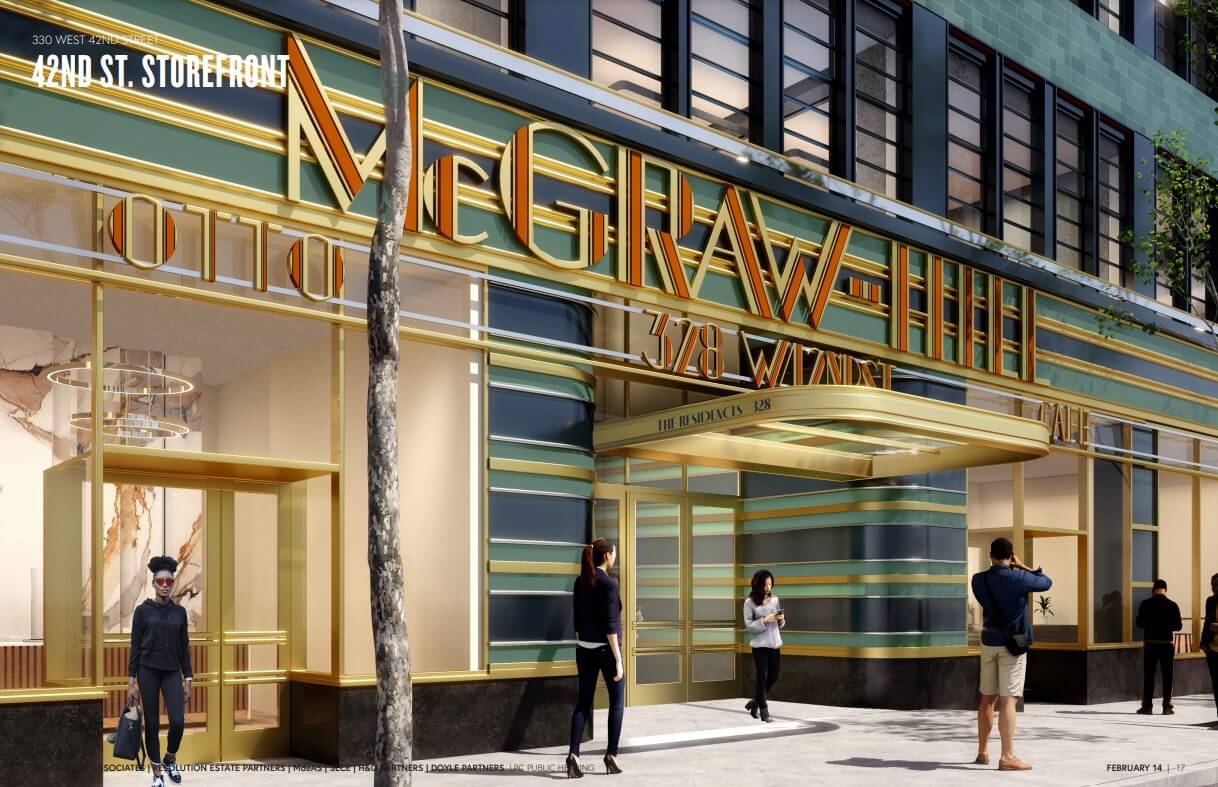
The change will make the 35-story McGraw-Hill tower the latest in a series of landmark office buildings and hotels in Manhattan to be converted at least partially to residences. It represents a major departure from development plans announced two years ago, when the building’s owners said they wanted to change the building from a single-user office tower to a multi-tenant office building, with a new lobby designed to accommodate the different tenants who move in.
Local preservationists have been largely supportive of the change in plans and are using it to urge the building’s owners to take its lobby back to the way it looked when Raymond Hood designed it for McGraw-Hill in the 1930s. They want the developers to reverse changes made in 2021, when the building was still being marketed entirely for office use.
Representatives for the building’s owners, Deco Tower Associates and Resolution Real Estate Partners, outlined the conversion plan both at the LPC hearing and during a Manhattan Community Board 4 (CB4) Land Use Committee meeting last month, a citizens panel that monitors development activity in the area where the landmark tower is located. The meetings were the first times they have spoken in detail publicly about their latest plans; more details came out during the CB 4 meeting.
On January 11, Julie Rosen of Higgins Quasebarth & Partners, a preservation consultant to the developers, told CB4 members that the development team is planning to convert floors 12 to 34 of the tower to 224 market-rate apartments; and lease floors 2 to 11, containing about 300,000 square feet of space, as office space.
Rosen, an associate with Higgins Quasebarth, said the upper-level apartments will be studio and one-bedroom units with “work from home” areas planned as part of the design, and space at street level will be leased for retail use. None of the apartments will be marketed as affordable housing, the developers said.
Rosen said the developers already have invested $135 million to upgrade the building’s mechanical systems and other infrastructure and to restore its exterior in accordance with plans approved by the LPC in 2021. She said converting the upper floors to apartments is seen as a way to fill the building with tenants at a time when New York City has high office vacancy rates.
“Even with all of these improvements, it has still become apparent that it’s going to be incredibly difficult to lease the entirety of the building to commercial tenants in this depressed, post-COVID office market,” she told the CB4 members. “So in order to ensure the long-term vitality of the building and the preservation of all the components, the owner is proposing to convert just the upper floors of the building to residential use while retaining the lower floors for commercial use.”
“The office market has changed drastically since we began this project,” Gerard Nocera, managing partner of Resolution Real Estate Partners, told the CB4 members in January. “We’re actively in the market. So we’re running on both cylinders, residential and commercial. It was not an easy decision from an economic standpoint…But from a supply-and-demand standpoint, it was obvious.”
Moderne/International Style landmark
Designed by Raymond Hood in association with Frederick Godley and Jacques Andre Fouilhoux, the 552,000-square-foot building was constructed in 1931 for the McGraw-Hill Publishing Company and is an example of the Moderne/International Style.
Listed on the National Register of Historic Places in 1980, it’s one of three buildings in New York City that’s associated with McGraw-Hill, but the company hasn’t occupied it for years.
In addition to Higgins Quasebarth, the design team includes SLCE Architects and MdeAS Architects, with Dan Shannon of MdeAS as managing partner in charge of the project.
Rosen said the building lends itself to partial residential conversion because its upper levels aren’t as deep as the lower levels, making it easier to get natural light into apartments.
“The upper floors are uniquely adaptable to this residential use because they were originally designed to house the McGraw-Hill offices with more access to natural light than on the lower, deeper floorplates, which were intended for manufacturing and printing uses,” she said at the CB4 meeting.
The team came to the LPC because it wanted approval to modify the building’s exterior to create two distinct entrances, one for residential tenants and one for office tenants. Located at 330 West 42nd Street, the building in 1979 was designated an individual New York City landmark, meaning that any changes to its exterior must be reviewed and approved by the LPC as part of the construction permit process.
The LPC approved modifications to the building’s exterior when the developers sought to upgrade it for multi-tenant office use. The developers this week were seeking to amend the certificate of appropriateness that the LPC issued in 2021, to permit the two entrances and other exterior changes associated with the residential conversion. The LPC voted 8 to 0 to approve most of what the design team requested, enabling the project to move forward.
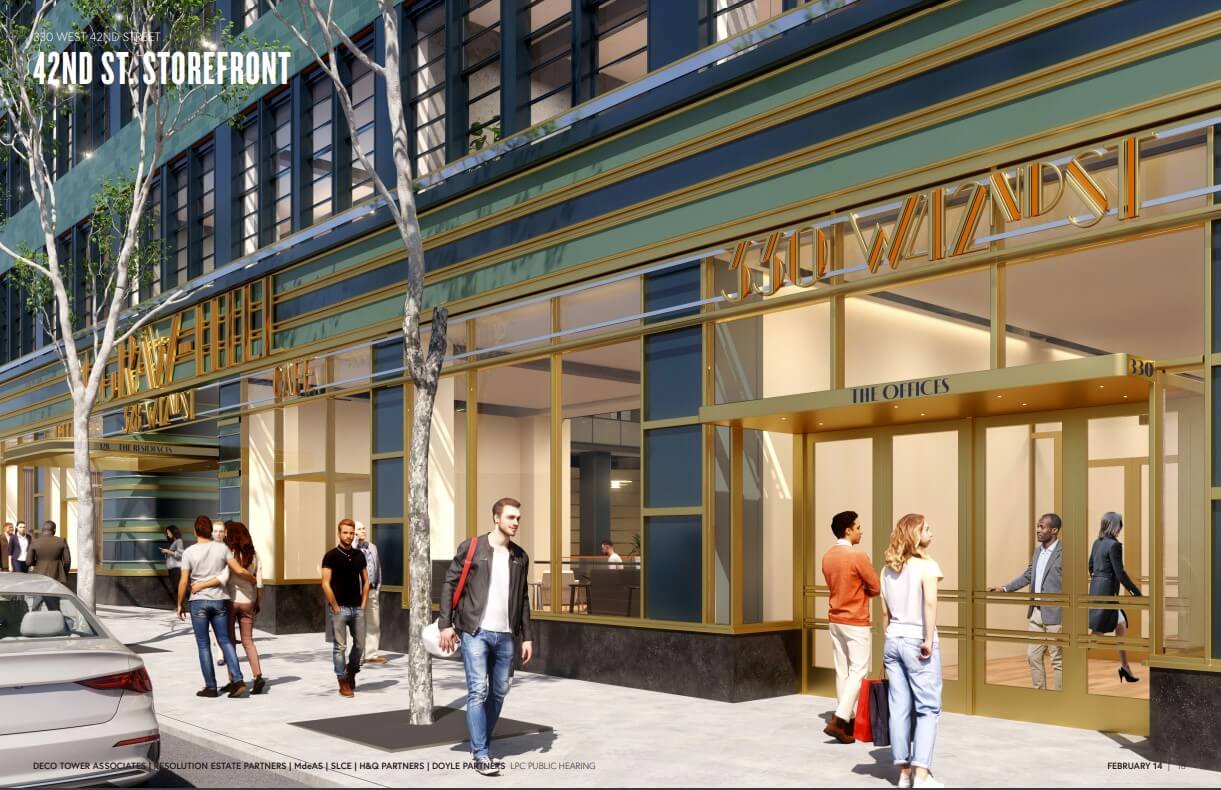
Under the developers’ new plan, the two main entrances would both be on the building’s 42nd Street side, its primary façade. The original office entrance would become the residential entrance, with different proportions for the doors and other “brass and glass infill,” and a retail bay at the far west end of the 42nd Street façade would be modified to serve as the main entrance to the offices.
The design team proposed a “cantilevered marquee” to rise above the new residential entrance, but the LPC did not approve that part of the design, with commissioners saying it was inconsistent with Hood’s vision and they did not see the need for it. Preservationists testifying at the LPC hearing also objected strongly to the marquee. LPC Chair Sarah Carroll said the designers could come back to the LPC with a revised marquee proposal if they chose, but she didn’t want to hold up the rest of the project for that item.
A secondary entrance for office and residential tenants will be on the building’s 41st Street side. The developers are also seeking permission to create some doorways and partitions to give apartment tenants access to terraces on the 16th and 32nd levels, modifications that Carroll said the LPC is reviewing at the staff level.
Questions about the lobby
During both the CB4 and LPC meetings, panel members asked what the new direction in leasing means for the building’s original lobby, which was essentially demolished when the developers began renovating the building for multi-tenant office use in 2021.
At the time, the lobby renovations sparked controversy because the developers said they couldn’t preserve the original Raymond Hood-designed lobby. They said a multi-tenant office building needs a different lobby design than the one that Hood created when McGraw-Hill was the building’s sole occupant. They said they wanted to create a multi-level lobby that was larger and had more amenities than the one Hood designed.
Leading the opposition to change was a group called the Alliance to Save the McGraw-Hill Lobby, co-founded by Theodore Grunewald and Thomas Collins. They argued that the McGraw-Hill building had “one of New York City’s finest art deco lobbies,” an “astonishing polychromatic Emerald City extravaganza” that should be preserved. They noted that Hood designed the interior and exterior to be experienced together, with one flowing into the other, and that replacing it with a less exuberant design would undermine Hood’s vision.
The Art Deco Society of New York called the lobby “a globally recognized architectural masterpiece” and “one of New York City’s most over-the-top art deco interiors.” An online petition to preserve the lobby got nearly 1,400 signatures.
The petition noted that the lobby walls bore “an important, unmistakable resemblance” to the building’s exterior, and praised the way its “alternating blue and green steel bands separated by silver and gold-colored metal tubes at the main entrance are seamlessly carried into the lobby to complement its green enameled steel walls.”
Preservationists appealed to the LPC in 2021 to block the lobby changes, but the commissioners said the interior wasn’t protected by landmark status and they didn’t have the legal authority to do so. The interior wasn’t protected because the commission in 2015 had turned down a request to give it landmark status. The commissioners said the lobby didn’t meet their criteria for interior landmark designation because it had been altered in the 1980s and no longer reflected Hood’s original design. They declined again in 2021 to consider interior landmark designation for the lobby.
By mid-March of 2021, the developers had stripped out much of the lobby as part of their effort to prepare the building for multi-tenant office use. At the time, they said they would salvage and store as many of the components of the lobby as they could, for possible reuse in the building.
Lobby restoration urged
At the community board meeting in January, several members asked about the architectural components of the lobby that had been preserved and whether they could be reinstalled in the residential lobby.
“Is the plan to reinstall, in a restored fashion, those elements there, to reuse them somehow? Is that the general idea?” asked board member Joe Restuccia. “We understood where they’re entering, but it wasn’t clear what was being restored.”
Restuccia said that he thought that, in light of the previous controversy, it would help the developers to be able to say they were bringing back elements of the original lobby.
“It would be very helpful to the discussion,” he said. “It shows that you’re trying to do something different from when you started.”
Rosen told the community board in January that “all of the original intact materials that were still in the lobby were salvaged for installation in the new lobby.” Shannon of MdeAS said the developers are no longer planning a multi-level lobby and that the residential lobby will take up essentially the same volume and footprint as Hood’s lobby did.
But at this point, the team does not yet have a final design to show exactly how the salvaged lobby pieces will be incorporated, Rosen and Shannon told the community board.
“To be honest, some of the decisions are still in progress,” Rosen said. “So we’re not quite prepared to discuss specifics tonight.”
“We do not have that design,” Shannon said. “It’s a planning diagram at this point.”
Shannon echoed Rosen in saying that the team fully intends to reuse the Hood-era lobby elements that were salvaged, but he stopped short of saying where they would be placed.
“We’re very sensitive to the concern for this historic, iconic landmark, and also the issue of the historic fabric that existed in the lobby,” he told the board members. “All of the historic fabric that we identified had been removed and stored. They are elements of doors and other metal elements—elevator doors, entry doors—and it is our intent in design planning that those components are integrated into the … residential lobby as well as the commercial lobby throughout the building.”
Restuccia encouraged the designers to incorporate as much as they can, as a way of building goodwill for the project. “It will go a long way toward diffusing that issue,” he said.
“Anything you could do in terms of the lobby, in putting back the original material that was in very good shape because it wasn’t exposed to the weather, in a sensitive way, would be very welcome,” added board member David Holowka. “Even though it’s not under Landmarks’ purview, that’s something that can earn you a lot of public support for parts of the project that are under public purview.”
LPC testimony
At the LPC hearing, Carroll said the lobby design was not within the scope of the plan under review and the panel would not take any official action on it.
But in public testimony about the changes, seven speakers urged the development team to use the salvaged materials and bring the lobby back to its original condition, as much as possible. The speakers were from preservation-oriented groups such as the Art Deco Society of New York, the Historic Districts Council, the Victorian Society New York, and the Alliance to Save the McGraw-Hill Lobby.
One of the LPC commissioners, architect Michael Goldblum, also indicated that he’d like to see the lobby “restored to the greatest extent possible.”
Grunewald, with the Alliance to Save the McGraw-Hill Lobby, said he believes the plan to add apartments with their own designated lobby gives the developers a perfect opportunity to bring back Hood’s original design. He said the lobby was largely an architectural kit of parts that lend themselves to reassembly, and that he thought doing so would help the owners market the apartments to prospective renters.
“Since the residential lobby’s footprint, cubic volume, function, and circulation are nearly identical to the 1932 configuration, logic dictates that the fragments are reunited to create the most breathtakingly sophisticated, elegant, and historically-significant apartment lobby in New York,” he said.
“The Alliance urges the owner and architect to do the right thing not only for themselves but for the hundreds and thousands of people throughout the world who cherish this unique hybrid of International Style–Streamlined Moderne, like Philadelphia’s PSFS Building,” he continued. “The owner could reap a goldmine, but only if they do the right thing and restore this extraordinary lobby.”
George Calderaro of the Art Deco Society of New York said he thought restoring Hood’s lobby would give the building a one-of-a-kind feature that would help it stand out from others on the market.
“The success of the building’s residential conversion will doubtless benefit from the prestige of its history and design,” he said. “It would seem only logical to build on that prestige by restoring Raymond Hood’s originally designed lobby as much as possible.”
Lucie Levine of the Historic Districts Council similarly urged the developers to restore the lobby to its “original art deco splendor.”
The development team is aiming to begin “white boxing” the building’s office floors in the next two months and to start work on the residential conversion within six months, Nocera said at the Community Board 4 meeting in January. Under that schedule, he said, the 224 apartments could be ready for occupancy sometime in 2024.








